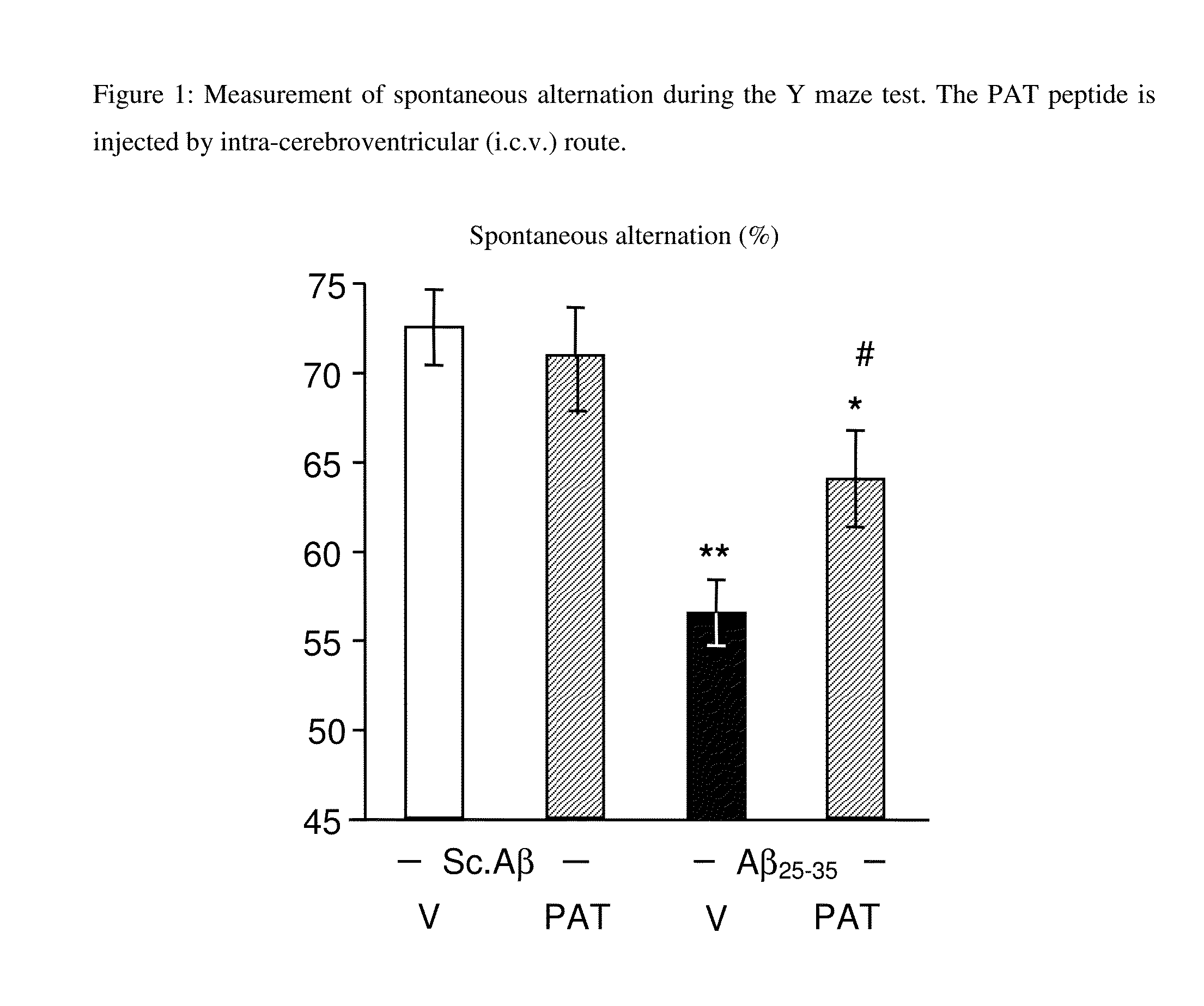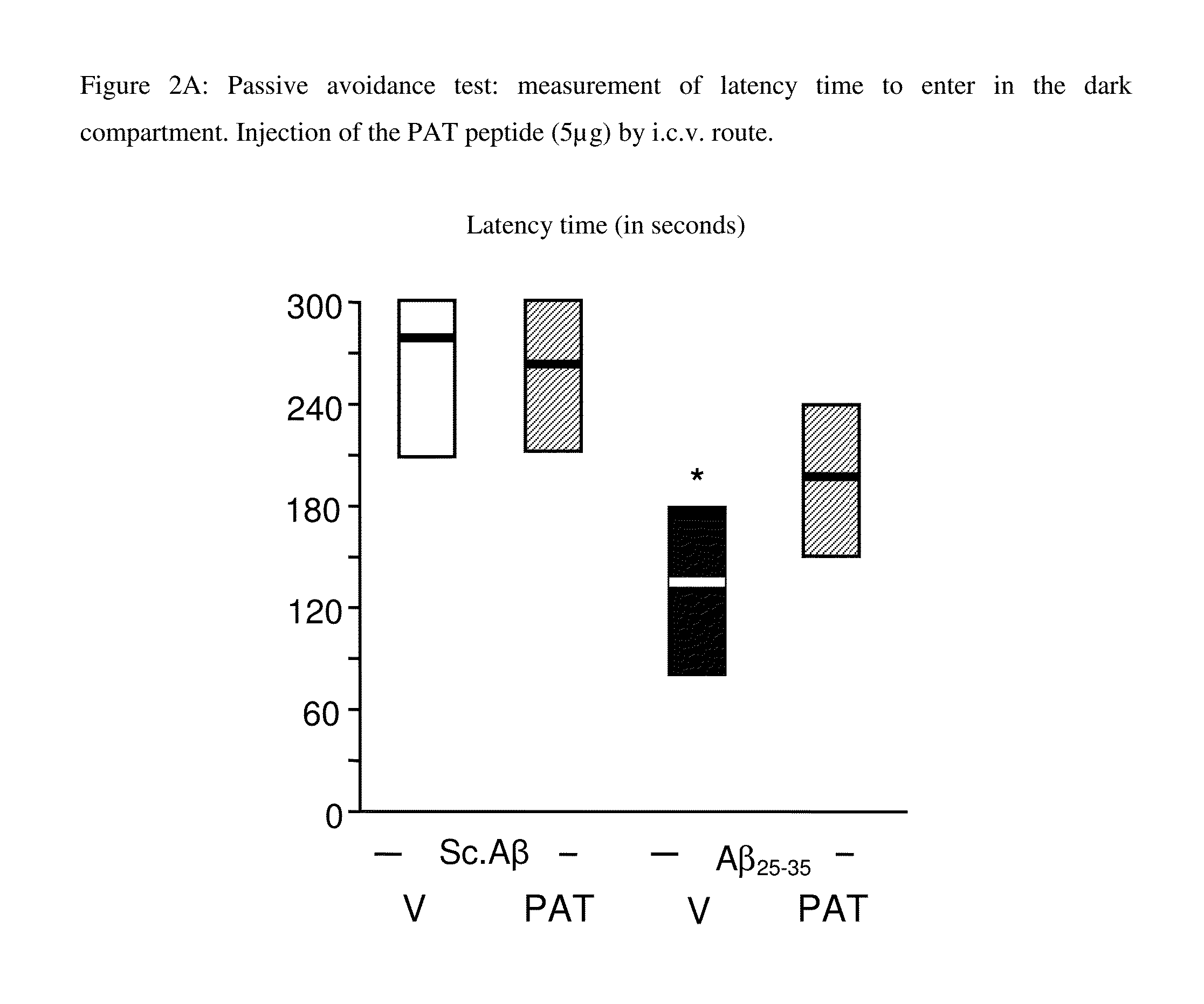Use of the pat nonapeptide in the treatment and prevention of neurodegenerative diseases
a non-amyloid, neurodegenerative disease technology, applied in the direction of peptide/protein ingredients, neurodegeneration, metabolism disorders, etc., can solve the problems of only affecting the symptoms of treatment, the death of the nervous cell, and the half-response of patients who received these drugs to treatment, etc., to achieve the effect of slow diffusion of the pat peptid
- Summary
- Abstract
- Description
- Claims
- Application Information
AI Technical Summary
Benefits of technology
Problems solved by technology
Method used
Image
Examples
example 1
Alzheimer's Model in Mice—Spontaneous Alternation Test
[0029]Experimental Protocol
[0030]The Swiss OF-1 (Depré, St Doulchard, France) mice were 7-9 weeks old from and weigh 32±2 g. They were dispatched into several groups and placed in plastic cages. They had free access to food and water, except during the behavioral experiments, and were maintained in an environment controlled (23±1° C., 40-60% of moisture) with light / darkness cycles of 12 hrs (light on at 8:00 am). The experiments were carried out between 9:00 am and 5:00 pm, in a room of experimentation. The mice were acclimated during 30 minutes before the beginning of the experiment. All the protocols followed the directives of the European Union dating of Nov. 24, 1986.
[0031]Treatment
[0032]The PAT peptide (5 μg) synthesized by Polypeptide (Denmark) was solubilized in distilled water and was administered by intra-peritoneal (i.p.) route in a volume of 100 μl (by 20 g of body weight) or by intra-cerebroventricular (i.c.v.) route ...
example 2
Alzheimer's Model in Mice—Passive Avoidance Test
[0041]Experimental Protocol:
[0042]The information relative to the mice, the peptides, their administration and the treatment groups are similar to those of Example 1.
[0043]Test Course. Tested Parameters
[0044]The compounds were administered 30 minutes before the test. This test allowed the evaluation of the long term non-spatial memory. The device in the test consisted of an enlightened compartment having white PVC walls (with width / length / height dimensions of 15-20-15 cm respectively); an obscure compartment having black PVC walls (with same dimensions) and a grid on the ground. A trap door separated the 2 compartments. A lamp of 60 W was positioned 40 cm above and lightens the white compartment during the experiment. On the grid, random electric shocks of 0.3 mA were delivered to the mice legs during 3 seconds from a random power generator (Lafayette Instruments, USA).
[0045]The 1st phase of the experiment called “training” was carried...
example 3
Cellular Model of Parkinson's Disease—Survival of Rat Primary Dopaminergic Neurons after 6-Hydroxydopamine Injury
[0052]6-hydroxydopamine (6-OHDA) is a selective catecholaminergic neurotoxin that is not only used as a pharmacological agent able to trigger PD-like stigmata (Sauer H. and Oertel W H Neuroscience 1994; 59: 401 and Cass W A et al. Brain Res. 2002; 938: 29) but also likely corresponds to a natural dopaminergic catabolite that accumulates in PD-affected brains and that appears to strongly contribute to this pathology (Jellinger K. et al. J. Neural. Transm. 1995; 46: 297). For this reason, 6-OHDA-induced dopaminergic neurotoxicity in mice is widely used as a model for PD research. Because 6-OHDA also induces neurodegeneration of dopaminergic neurons in vitro, it provides a useful model of PD. In this in vitro test mesencephalic dopaminergic neurons are exposed to 6-OHDA injury. Neuroprotective effect of a test compound is evaluated by pre-incubating the mesencephalic neurons...
PUM
| Property | Measurement | Unit |
|---|---|---|
| Mass | aaaaa | aaaaa |
| Mass | aaaaa | aaaaa |
| Mass | aaaaa | aaaaa |
Abstract
Description
Claims
Application Information
 Login to View More
Login to View More - R&D
- Intellectual Property
- Life Sciences
- Materials
- Tech Scout
- Unparalleled Data Quality
- Higher Quality Content
- 60% Fewer Hallucinations
Browse by: Latest US Patents, China's latest patents, Technical Efficacy Thesaurus, Application Domain, Technology Topic, Popular Technical Reports.
© 2025 PatSnap. All rights reserved.Legal|Privacy policy|Modern Slavery Act Transparency Statement|Sitemap|About US| Contact US: help@patsnap.com



